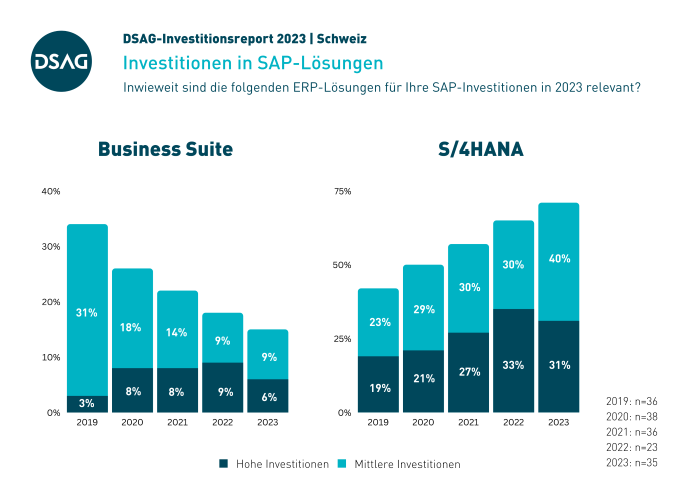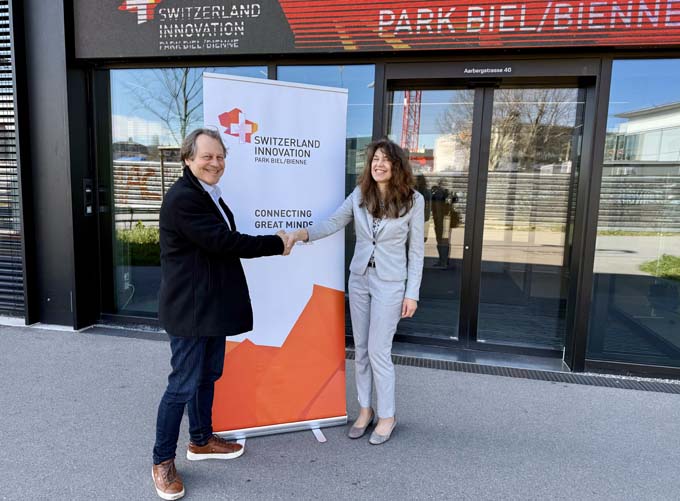SAP solutions: Swiss companies continue to invest
The willingness to invest in IT and SAP is unbroken among Swiss companies. Nevertheless, S/4HANA cloud solutions are not yet an option in many places. On the other hand, the topic of cybersecurity is becoming increasingly relevant. This is shown by the current DSAG investment report for Switzerland.

The German-speaking SAP User Group e. V. (DSAG) is one of the most influential user associations in the world. The Swiss branch recently presented the results of the DSAG Investment Report. "After the Corona pandemic, Swiss companies continue to pick up speed. The high willingness to invest in IT and in SAP solutions in particular are the indicators of this," says Jean-Claude Flury, DSAG Switzerland board member. Compared to 2022, the IT budgets of the Swiss companies surveyed are increasing at 51 percent (DACH: 54 percent), remaining the same at 31 percent (DACH: 26 percent) and decreasing at 14 percent (DACH: 15 percent). 3 percent of respondents did not provide any information. SAP budgets are also increasing for 51 percent (DACH: 52 percent), staying the same for 29 percent (DACH: 31 percent) and decreasing for 20 percent (DACH: 15 percent). "The DACH trend in terms of investments is also continuing in Switzerland. Here, too, one of the decisive factors is likely to be the fact that some established SAP solutions will soon be coming out of maintenance and the project agendas are already full to bursting with S/4HANA implementation projects," says Jean-Claude Flury.
S/4HANA public cloud solutions not yet an option
At 63 percent (DACH: 79 percent), SAP Enterprise Resource Planning or SAP Business Suite leads the field in terms of SAP ERP solutions used. By comparison, this was the case for 65 percent of respondents in 2022. S/4HANA on-premise is used by 51 percent (DACH: 41 percent) of respondents. In 2022, 57 percent of respondents in Switzerland stated this. However, the small number of survey participants must be taken into account here when interpreting the figures.
This is followed by the S/4HANA private cloud with 17 percent (DACH: 8 percent), which was used by 4 percent of respondents a year ago. S/4HANA Public Cloud, on the other hand, plays no role in Switzerland this year (2022: 4 percent). "In the private cloud, the advantages from already widely accepted operating models of outsourcing are combined with a standardization of the solution and its operation. SAP customer companies in Switzerland seem to view this increasingly positively. In any case, I do not see most companies using the public cloud model in all processes in the short and medium term. There is still too much functionality missing," says Jean-Claude Flury.
S/4HANA leads the way in investment planning
Nevertheless, Swiss companies have recognized that there is no way around S/4HANA. For example, the Business Suite is relevant for high investments at 6 percent (DACH: 6 percent) and for medium investments at 9 percent (DACH: 22 percent). In S/4HANA, 31 percent (DACH: 28 percent) plan high investments and 40 percent (DACH: 38 percent) medium investments. For S/4HANA, this is an increase of 10 percentage points for medium investments and a decrease of four percentage points for high investments compared to 2022. And for Business Suite, this means a slight decrease of 3 percentage points for high investments and an unchanged value of 9 percent for medium investments. (see chart)

"Swiss companies are aware of the fact that they will have to switch from an old ERP system to S/4HANA by 2027 or 2030. Because that is when older systems will run out of maintenance," knows Jean-Claude Flury. The appeal of the Switzerland board member is: "Companies should decide quickly how they want to make the switch. A purely technical migration to S/4HANA hardly brings any advantages. These only arise when processes are scrutinized and redesigned in an optimized manner. In addition, the functional scope of S/4HANA and SAP ECC is not identical. Therefore, companies may need additional applications and have to adapt existing interfaces. Against this background, it would be wrong to underestimate the effort required for a corresponding migration. The time window of four or seven years still seems wide open. But internal preparation, e.g., in terms of processes, in-house developments and data, as well as the selection of the appropriate partner for the changeover, take time."
Communicate BTP better
In terms of SAP cloud solutions, 6 percent say they will make high investments and 23 percent say they will make medium investments in SAP SuccessFactors (DACH: 3 percent high | 14 percent medium investments). In the SAP Business Technology Platform (BTP), 3 percent of Swiss respondents intend to make high investments (DACH: 4 percent) and 17 percent medium investments (DACH: 20 percent). Investments in this case mean increased spending on cloud solutions, including subscriptions. In third place among Swiss respondents is SAP Integrated Business Planning with 3 percent high and 9 percent medium investments. SAP Ariba and SAP Signavio follow with three percent each in both high and medium investments.
"The Business Technology Platform is the new central element in SAP's strategy. It is therefore somewhat surprising that Swiss companies are still exercising restraint in this regard. It seems that SAP customers still lack confidence in the new platform," says Jean-Claude Flury. Here, the country board member also sees a task for SAP. "We very much welcome the fact that the first migration services are now being developed, which are intended, for example, to support companies in converting their current integration architectures to the BTP Integration Suite. But these services still need to be communicated much better," explains Jean-Claude Flury.
Pricing policy makes it difficult to move to the cloud
In this investment report, respondents were also asked for the first time to rate SAP's pricing policy in the cloud environment. In Switzerland, 3 percent (DACH: 5 percent) describe themselves as satisfied. 17 percent (DACH: 20 percent) assess their status as neither satisfied nor dissatisfied, and 20 percent of respondents did not give any information (DACH: 26 percent). "Of course, it is noticeable that 60 percent of respondents in Switzerland do not rate SAP's pricing policy in the cloud environment positively. However, this is a generally unpopular topic that is likely to affect all providers of cloud solutions equally," says the Chief Operating Officer for Switzerland.
Nevertheless, the planned annual price increase for SAP cloud services has caused a lot of criticism among DSAG members. "From DSAG's point of view, it would be important to make it easier for companies to move to the cloud instead of making it more difficult. Because that is exactly what is happening through annual price increases. The clear reaction of SAP customers is therefore a clear signal that there is an urgent need for appropriate mechanisms to control the price development in the interest of all parties involved," says Jean-Claude Flury.
Security dashboard necessary
For this investment report, respondents were again asked about the relevance of overarching topics for investment planning. Here, cybersecurity is clearly in first place with 89 percent (2022: 74 percent) with high and medium relevance. In the DACH region, 88 percent see it that way. Process automation comes in second place, with 60 percent (2022: 48 percent) rating it as highly and moderately relevant. The importance of cybersecurity is beyond question for Jean-Claude Flury: "It is not possible to prevent hacker attacks. But there are ways and means to prepare for them. If only to keep the risk manageable."
An essential element in anticipation of security-relevant attacks is a security dashboard. DSAG has been demanding this from SAP for some time. Together with the software manufacturer, the interest group is working on a solution that automatically shows which security-relevant settings need to be made and where security gaps exist in the company's SAP landscape.
Besides technology, people themselves are the highest risk to IT security. "The DSAG security awareness campaign is an important tool for raising awareness of possible threat scenarios. The aim is to create awareness of how to deal with the issue of security and threats to SAP systems in an exemplary manner," says Jean-Claude Flury. Specifically, the industry association offers various training courses that are designed to help employees recognize possible threats at an early stage, ward them off, and prevent consequences from arising in the first place.
Source: DSAG









